Piezoelectric MEMS Energy Harvester for Low-Power Applications
Abstract
1. Introduction
2. Materials and Methods
3. Results
3.1. Device Fabrication
3.2. Frequency and Phase Measurements
3.3. Experimental Setup for Measurements
3.4. Device Characterization
3.5. Conversion Circuit
3.6. Device Characterization with the Conversion Circuit
4. Discussion
5. Conclusions
Author Contributions
Funding
Data Availability Statement
Acknowledgments
Conflicts of Interest
References
- Industrial Sensors Market Size, Share, Industry Report, Revenue Trends and Growth Drivers. Available online: https://www.marketsandmarkets.com/Market-Reports/industrial-sensor-market-108042398.html (accessed on 26 March 2024).
- The European Green Deal—European Commission. Available online: https://commission.europa.eu/strategy-and-policy/priorities-2019-2024/european-green-deal_en (accessed on 26 March 2024).
- Energy Harvesting System Market Size, Share, Industry Trends Forecast, Opportunities 2030. Available online: https://www.marketsandmarkets.com/Market-Reports/energy-harvesting-market-734.html (accessed on 26 March 2024).
- Wang, L.; Yuan, F.G. Vibration Energy Harvesting by Magnetostrictive Material. Smart Mater. Struct. 2008, 17, 045009. [Google Scholar] [CrossRef]
- Pan, C.T.; Liu, Z.H.; Chen, Y.C.; Chang, W.T.; Chen, Y.J. Study of Vibration-Induced Broadband Flexible Piezoelectric ZnO Micro-Harvester with Storage System. In Proceedings of the 2011 16th International Solid-State Sensors, Actuators and Microsystems Conference, Beijing, China, 5–9 June 2011; IEEE: Beijing, China, 2011; pp. 1669–1672. [Google Scholar]
- Li, Y.; Celik-Butler, Z.; Butler, D.P. A Piezoelectric Micro-Energy Harvester for Nanosensors. In Proceedings of the 2015 IEEE SENSORS, Busan, Republic of Korea, 1–4 November 2015; IEEE: Busan, Republic of Korea, 2015; pp. 1–4. [Google Scholar]
- Kanno, I.; Ichida, T.; Adachi, K.; Kotera, H.; Shibata, K.; Mishima, T. Power-Generation Performance of Lead-Free (K,Na)NbO3 Piezoelectric Thin-Film Energy Harvesters. Sens. Actuators A Phys. 2012, 179, 132–136. [Google Scholar] [CrossRef]
- Won, S.S.; Lee, J.; Venugopal, V.; Kim, D.-J.; Lee, J.; Kim, I.W.; Kingon, A.I.; Kim, S.-H. Lead-Free Mn-Doped (K0.5,Na0.5)NbO3 Piezoelectric Thin Films for MEMS-Based Vibrational Energy Harvester Applications. Appl. Phys. Lett. 2016, 108, 232908. [Google Scholar] [CrossRef]
- Fei, C.; Liu, X.; Zhu, B.; Li, D.; Yang, X.; Yang, Y.; Zhou, Q. AlN Piezoelectric Thin Films for Energy Harvesting and Acoustic Devices. Nano Energy 2018, 51, 146–161. [Google Scholar] [CrossRef]
- Jackson, N.; O’Keeffe, R.; Waldron, F.; O’Neill, M.; Mathewson, A. Evaluation of Low-Acceleration MEMS Piezoelectric Energy Harvesting Devices. Microsyst. Technol. 2014, 20, 671–680. [Google Scholar] [CrossRef]
- Liu, J.-Q.; Fang, H.-B.; Xu, Z.-Y.; Mao, X.-H.; Shen, X.-C.; Chen, D.; Liao, H.; Cai, B.-C. A MEMS-Based Piezoelectric Power Generator Array for Vibration Energy Harvesting. Microelectron. J. 2008, 39, 802–806. [Google Scholar] [CrossRef]
- Yu, H.; Zhou, J.; Deng, L.; Wen, Z. A Vibration-Based MEMS Piezoelectric Energy Harvester and Power Conditioning Circuit. Sensors 2014, 14, 3323–3341. [Google Scholar] [CrossRef] [PubMed]
- Zhao, X.; Shang, Z.; Luo, G.; Deng, L. A Vibration Energy Harvester Using AlN Piezoelectric Cantilever Array. Microelectron. Eng. 2015, 142, 47–51. [Google Scholar] [CrossRef]
- Barth, S.; Bartzsch, H.; Glöß, D.; Frach, P.; Modes, T.; Zywitzki, O.; Suchaneck, G.; Gerlach, G. Magnetron Sputtering of Piezoelectric AlN and AlScN Thin Films and Their Use in Energy Harvesting Applications. Microsyst. Technol. 2016, 22, 1613–1617. [Google Scholar] [CrossRef]
- Jia, Y.; Seshia, A.A. Power Optimization by Mass Tuning for MEMS Piezoelectric Cantilever Vibration Energy Harvesting. J. Microelectromech. Syst. 2016, 25, 108–117. [Google Scholar] [CrossRef]
- STM32L Series. Available online: http://www.st.com/en/microcontrollers/stm32l0-series.html?querycriteria=productId=SS1817 (accessed on 26 March 2024).
- MKW36A/35A/34A Data Sheet. Available online: https://www.nxp.com/docs/en/data-sheet/MKW36A512.pdf (accessed on 26 March 2024).
- MSP430 Ultra-Low-Power MCUs. Available online: http://www.ti.com/microcontrollers/msp430-ultra-low-power-mcus/products.html?pqs=paqs&familyid=342#~p3090=1.8V%20I/O (accessed on 26 March 2024).
- Williams, C.B.; Yates, R.B. Analysis Of A Micro-Electric Generator For Microsystems. In Proceedings of the International Solid-State Sensors and Actuators Conference—TRANSDUCERS ’95, Stockholm, Sweden, 25–29 June 1995; IEEE: Stockholm, Sweden, 1995; Volume 1, pp. 369–372. [Google Scholar]
- Matloub, R.; Hadad, M.; Mazzalai, A.; Chidambaram, N.; Moulard, G.; Sandu, C.S.; Metzger, T.; Muralt, P. Piezoelectric Al1−xScxN Thin Films: A Semiconductor Compatible Solution for Mechanical Energy Harvesting and Sensors. Appl. Phys. Lett. 2013, 102, 152903. [Google Scholar] [CrossRef]
- Priya, S. Criterion for Material Selection in Design of Bulk Piezoelectric Energy Harvesters. IEEE Trans. Ultrason. Ferroelectr. Freq. Control 2010, 57, 2610–2612. [Google Scholar] [CrossRef]
- Herdier, R.; Jenkins, D.; Remiens, D.; Dupont, M.; Osmont, D. A Silicon Cantilever Beam Structure for the Evaluation of D31, D33 and E31 Piezoelectric Coefficients of PZT Thin Films. In Proceedings of the 2007 Sixteenth IEEE International Symposium on the Applications of Ferroelectrics, Nara-City, Japan, 27–31 May 2007; pp. 725–727. [Google Scholar]
- Belavic, D.; Muscalu, G.; Vojisavljevic, K.; Hodnik, M.; Kuscer, D.; Kos, T.; Pecnik, T.; Drnovsek, S.; Zajac, J.; Malic, B.; et al. Ceramic Packaging of PiezoMEMS Devices. In Proceedings of the 2017 21st European Microelectronics and Packaging Conference (EMPC) & Exhibition, Warsaw, Poland, 10–13 September 2017; IEEE: Warsaw, Poland, 2017; pp. 1–4. [Google Scholar]
- TE Connectivity 820M1 Single Axis Condition Monitoring Accelerometer. Available online: https://www.te.com/commerce/DocumentDelivery/DDEController?Action=showdoc&DocId=Data+Sheet%7F820M1_Accelerometer%7FA4%7Fpdf%7FEnglish%7FENG_DS_820M1_Accelerometer_A4.pdf%7F20005838-00 (accessed on 26 March 2024).
- Muscalu, G.; Firtat, B.; Dinulescu, S.; Moldovan, C.; Anghelescu, A.; Stan, I. Power Harvesting and Storage Circuit for a Double Array of Lead-Free Piezoelectric Cantilevers. In Proceedings of the 2018 International Semiconductor Conference (CAS), Sinaia, Romania, 10–12 October 2018; IEEE: Sinaia, Romania, 2018; pp. 321–324. [Google Scholar]
- Linear Technology LTC3588-1—Nanopower Energy Harvesting Power Supply. Available online: https://www.analog.com/media/en/technical-documentation/data-sheets/35881fc.pdf (accessed on 26 March 2024).
- Liu, Y.; Hu, B.; Cai, Y.; Zhou, J.; Liu, W.; Tovstopyat, A.; Wu, G.; Sun, C. Design and Performance of ScAlN/AlN Trapezoidal Cantilever-Based MEMS Piezoelectric Energy Harvesters. IEEE Trans. Electron. Devices 2021, 68, 2971–2976. [Google Scholar] [CrossRef]
- Gablech, I.; Klempa, J.; Pekárek, J.; Vyroubal, P.; Hrabina, J.; Holá, M.; Kunz, J.; Brodský, J.; Neužil, P. Simple and Efficient AlN-Based Piezoelectric Energy Harvesters. Micromachines 2020, 11, 143. [Google Scholar] [CrossRef] [PubMed]
- He, X.; Li, D.; Zhou, H.; Hui, X.; Mu, X. Theoretical and Experimental Studies on MEMS Variable Cross-Section Cantilever Beam Based Piezoelectric Vibration Energy Harvester. Micromachines 2021, 12, 772. [Google Scholar] [CrossRef]
- Elfrink, R.; Kamel, T.M.; Goedbloed, M.; Matova, S.; Hohlfeld, D.; Van Andel, Y.; Van Schaijk, R. Vibration Energy Harvesting with Aluminum Nitride-Based Piezoelectric Devices. J. Micromech. Microeng. 2009, 19, 094005. [Google Scholar] [CrossRef]
- Muscalu, G.-S.; Varachiu, N.; Firtat, B.; Dinulescu, S.; Tulbure, A.; Moldovan, C. Vibrational Energy Harvesting Devices for Structural Health Monitoring—Design Optimization. In Proceedings of the 2020 International Semiconductor Conference (CAS), Sinaia, Romania, 7 October 2020; IEEE: Sinaia, Romania, 2020; pp. 151–154. [Google Scholar]
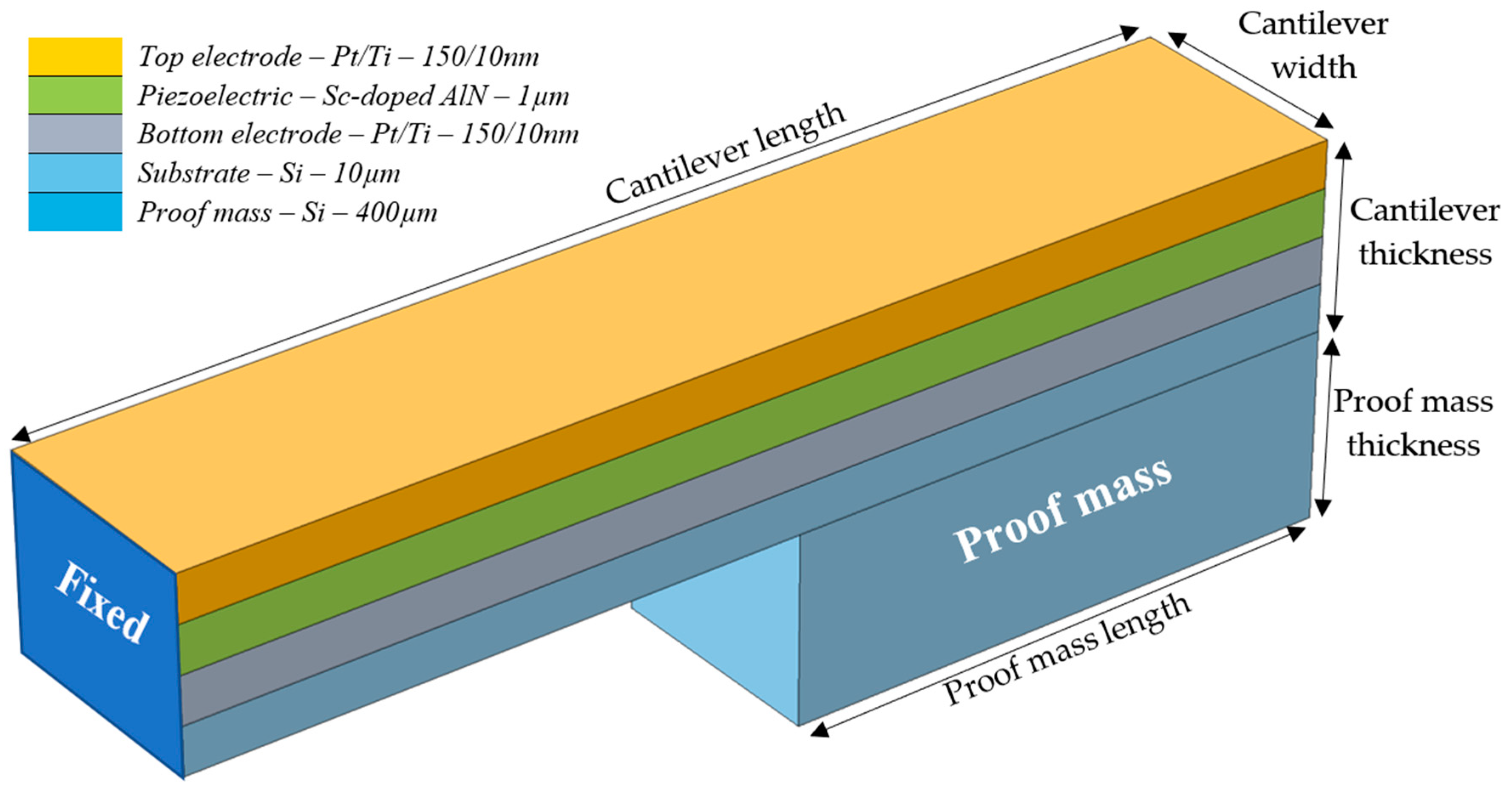

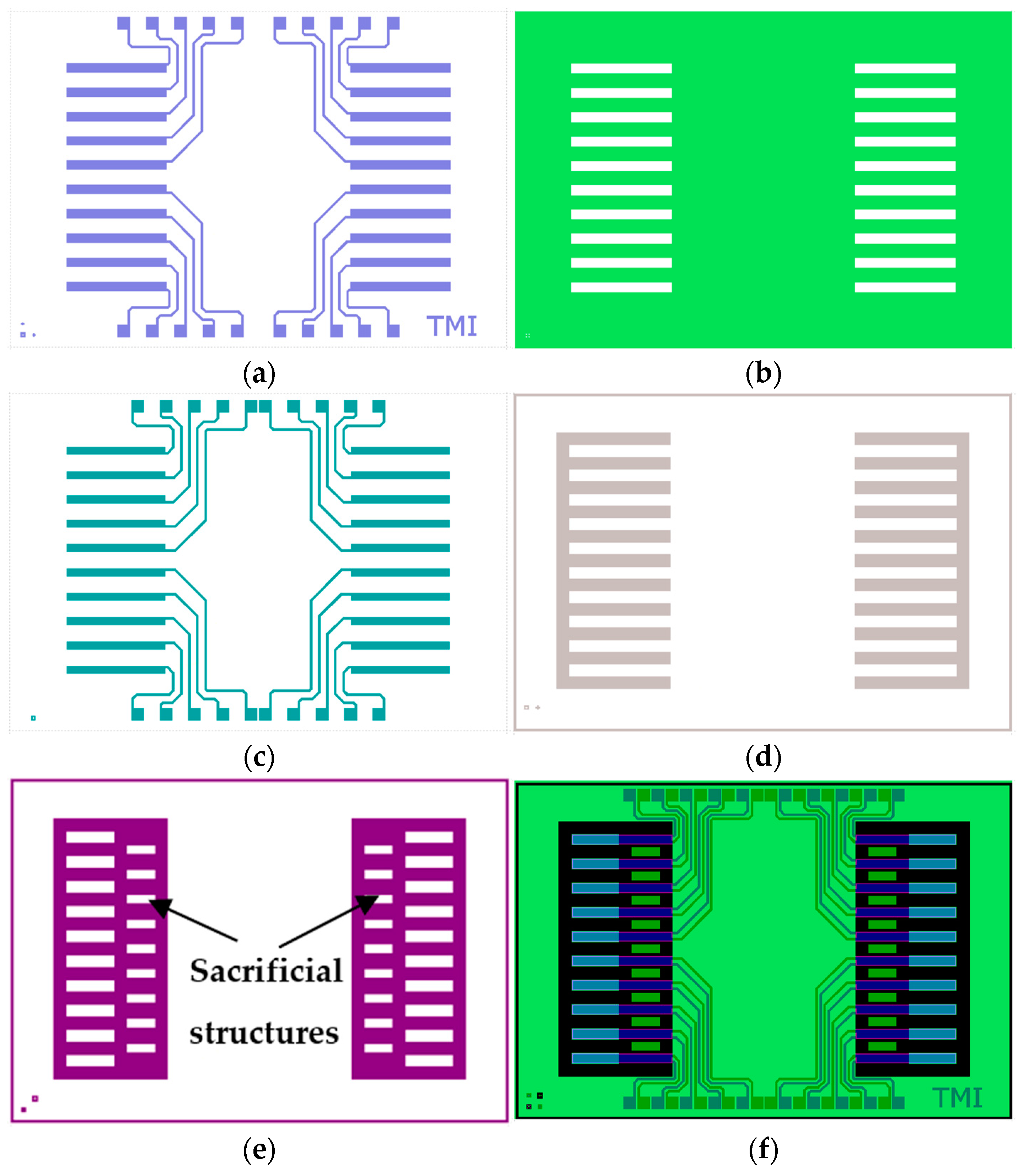


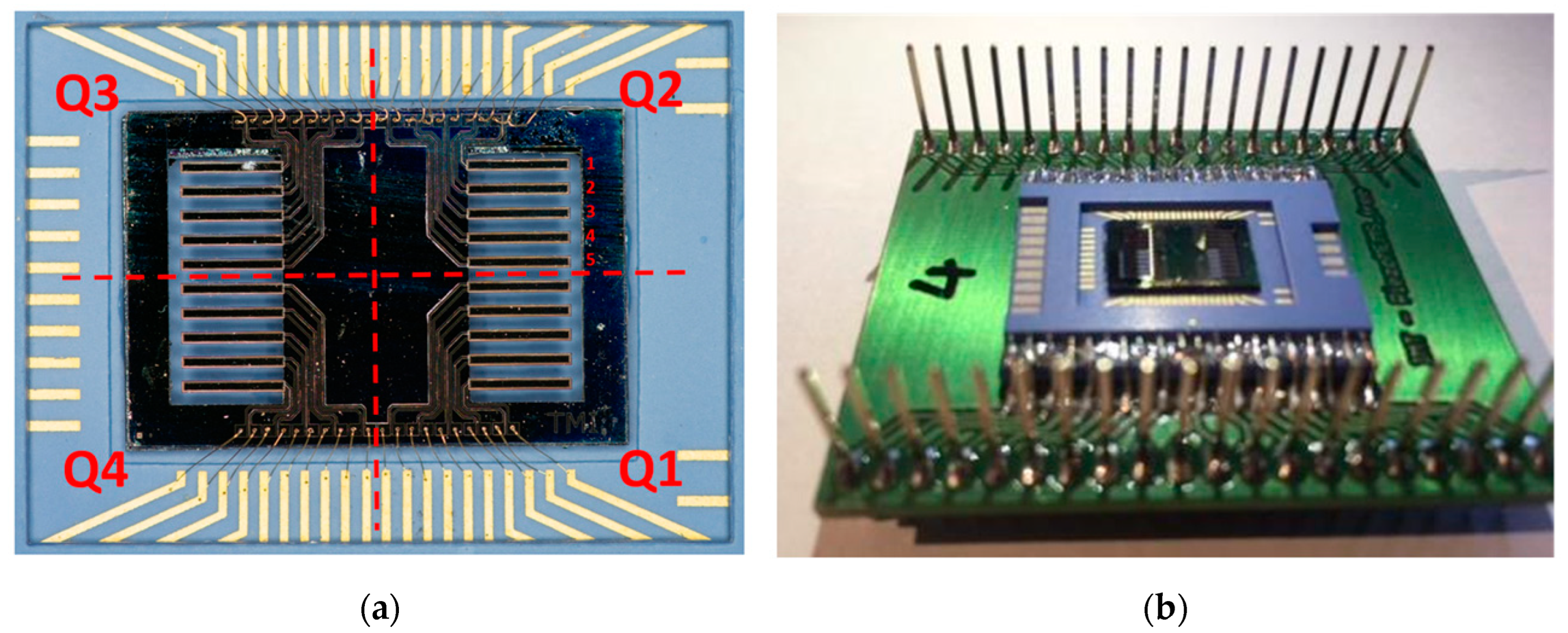
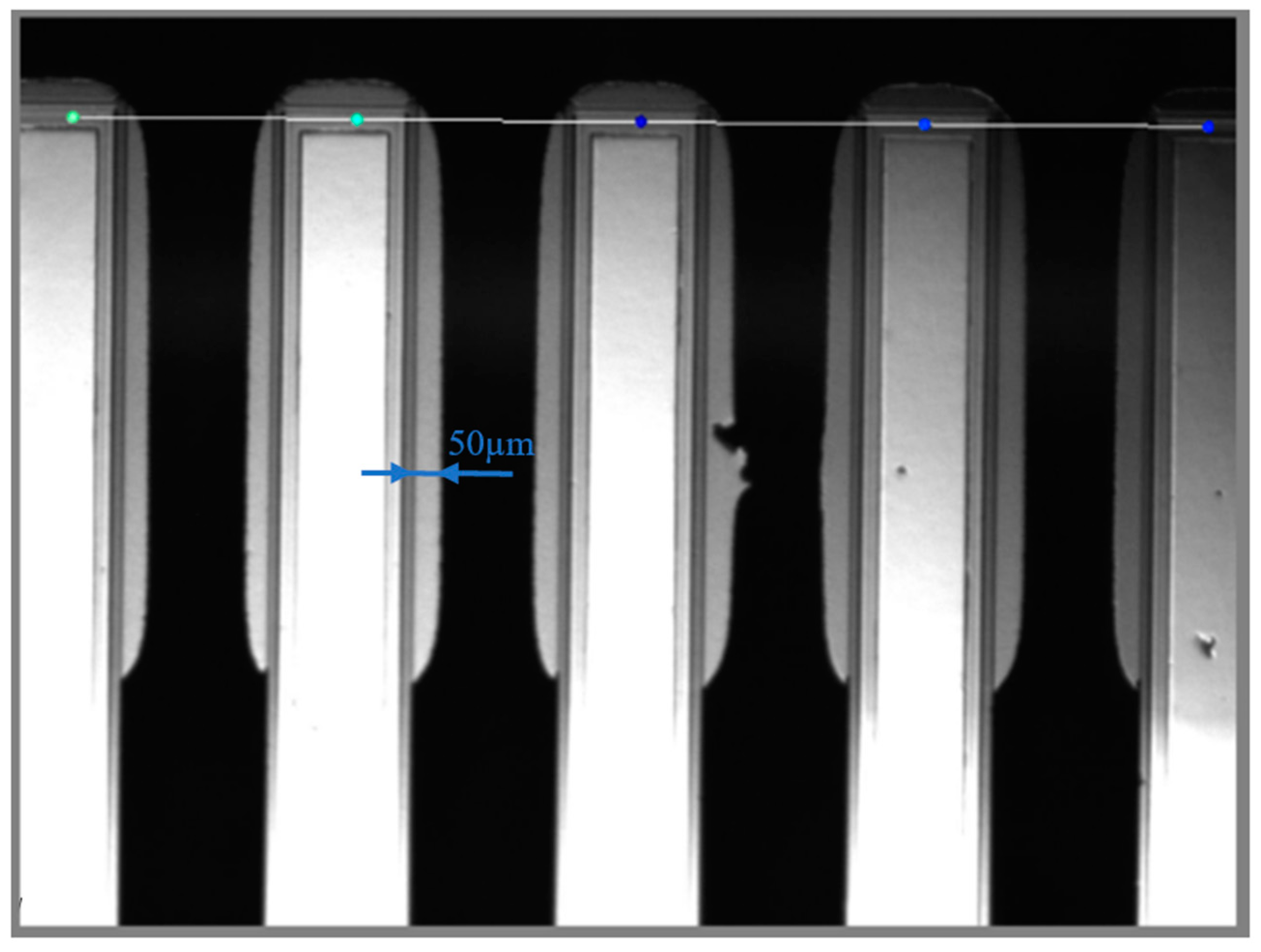

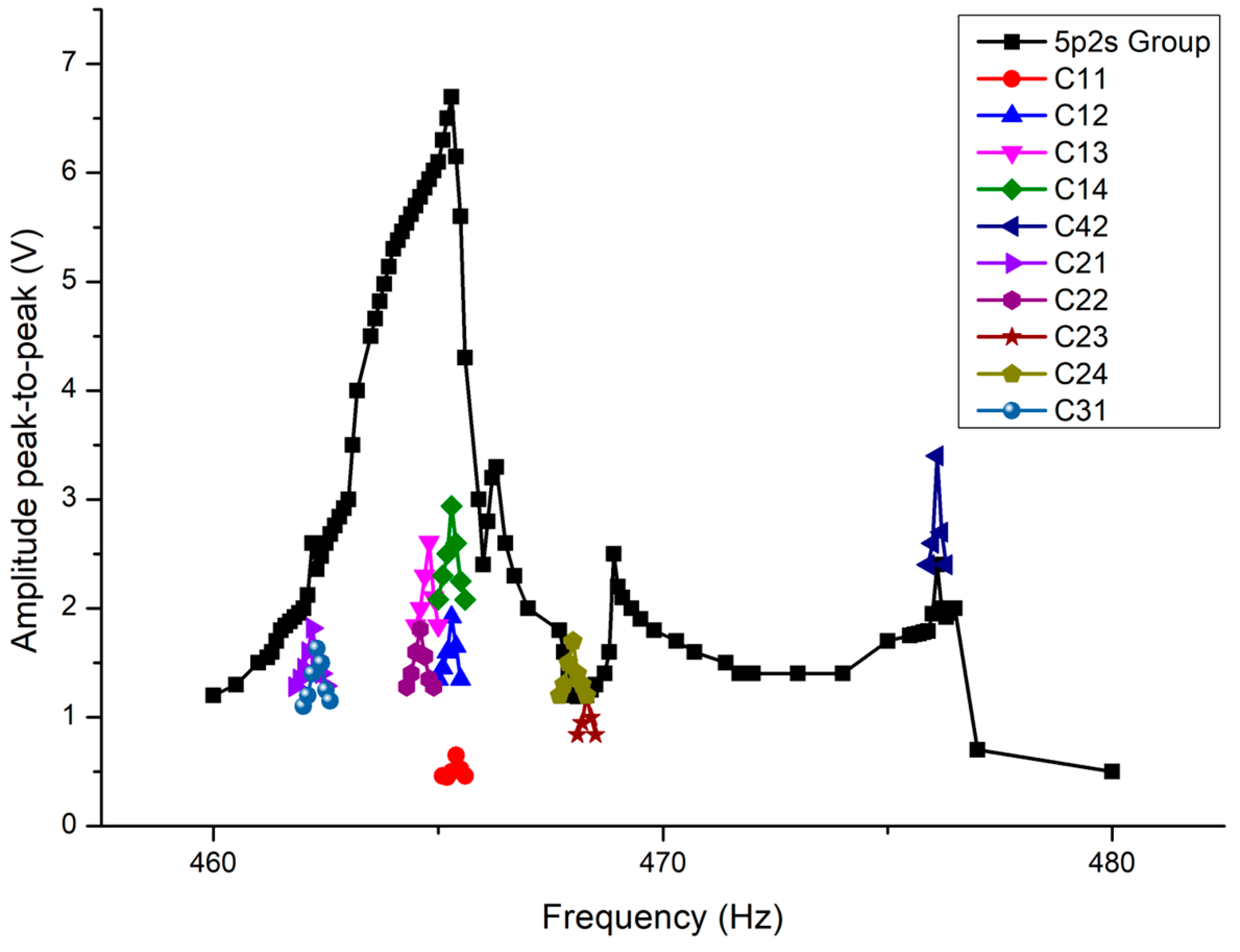
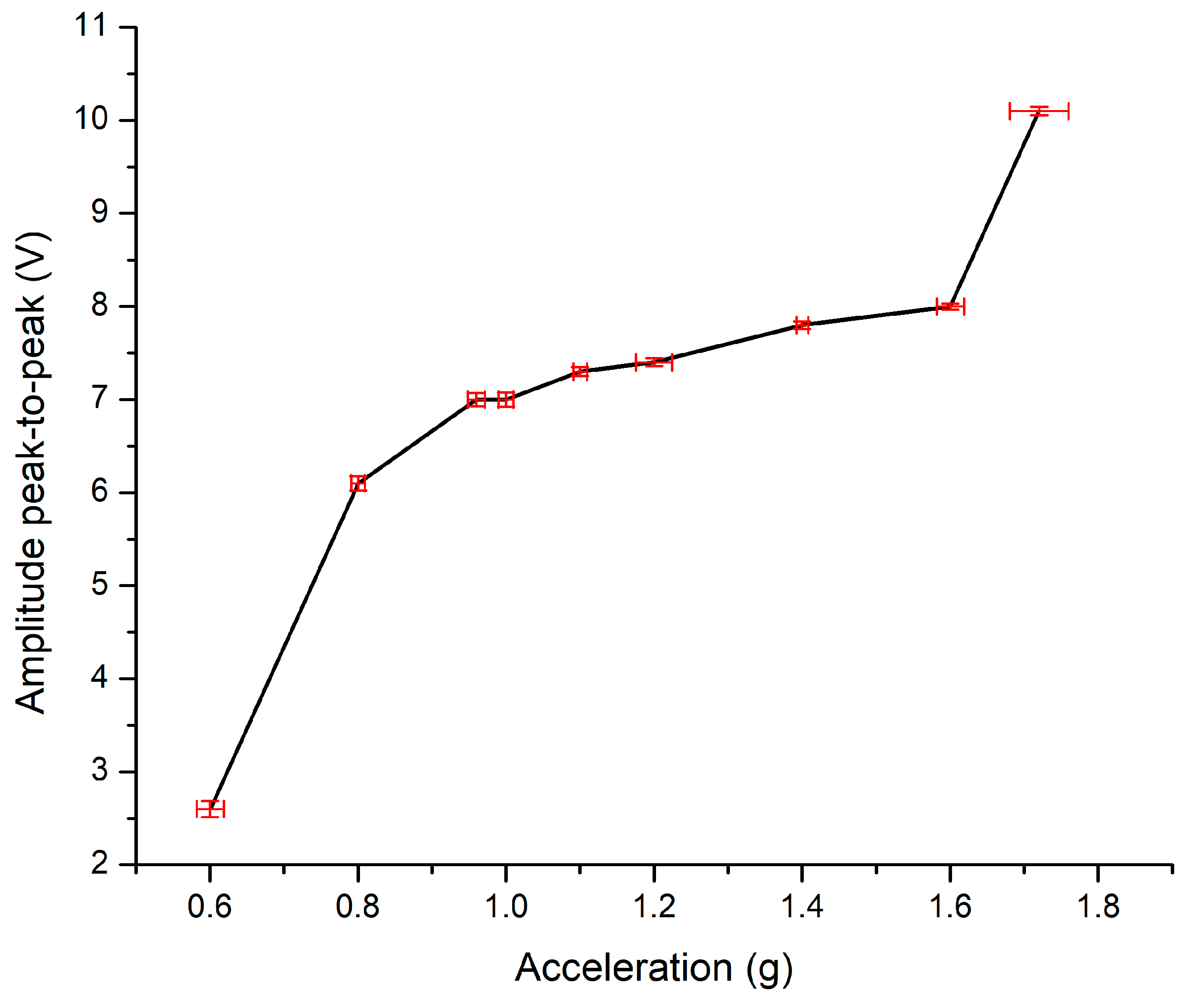

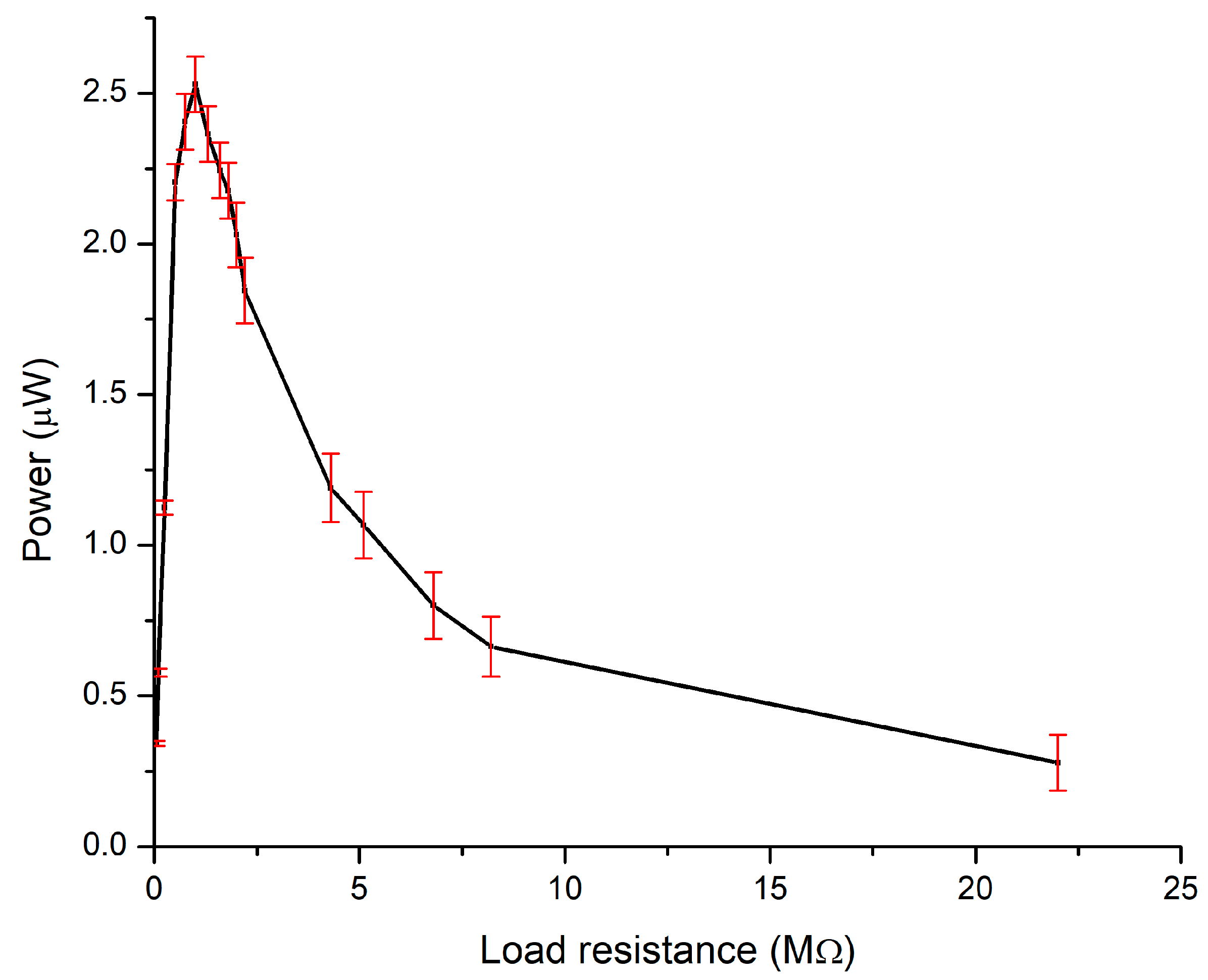

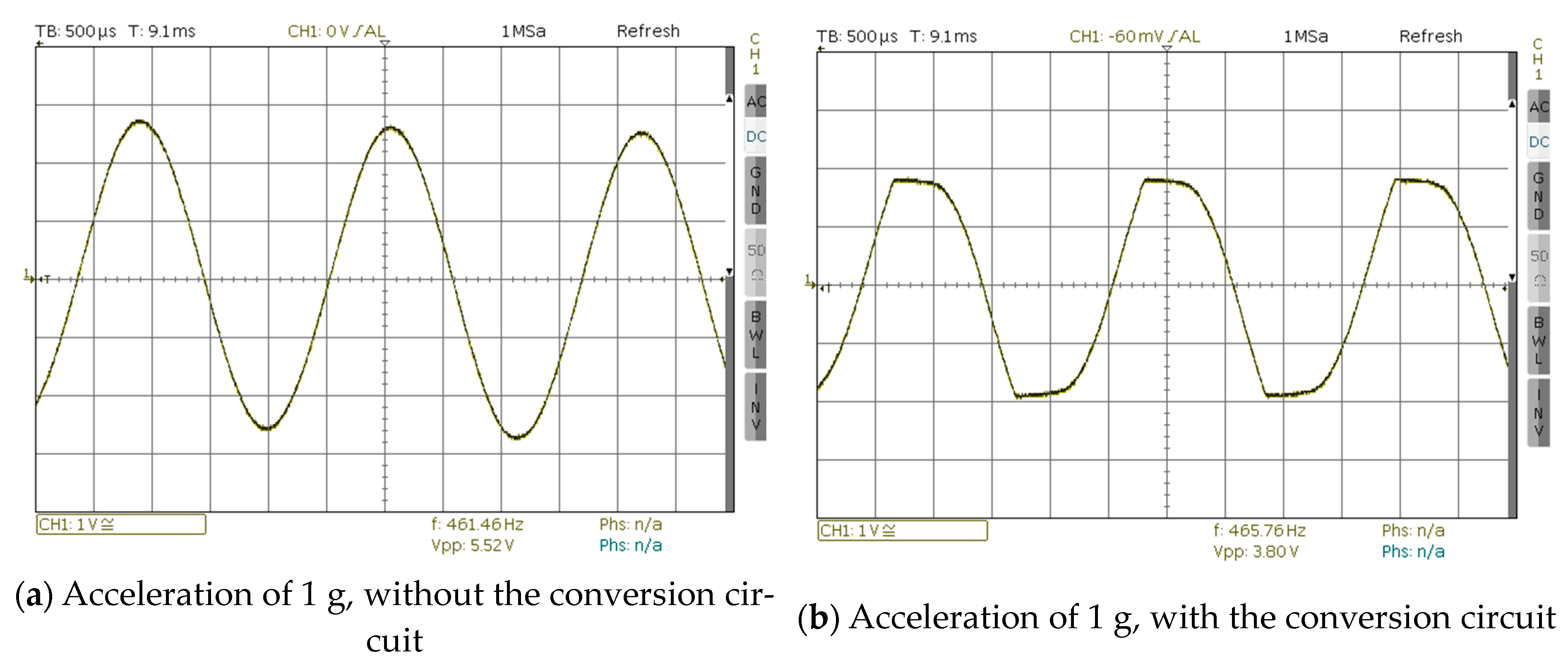


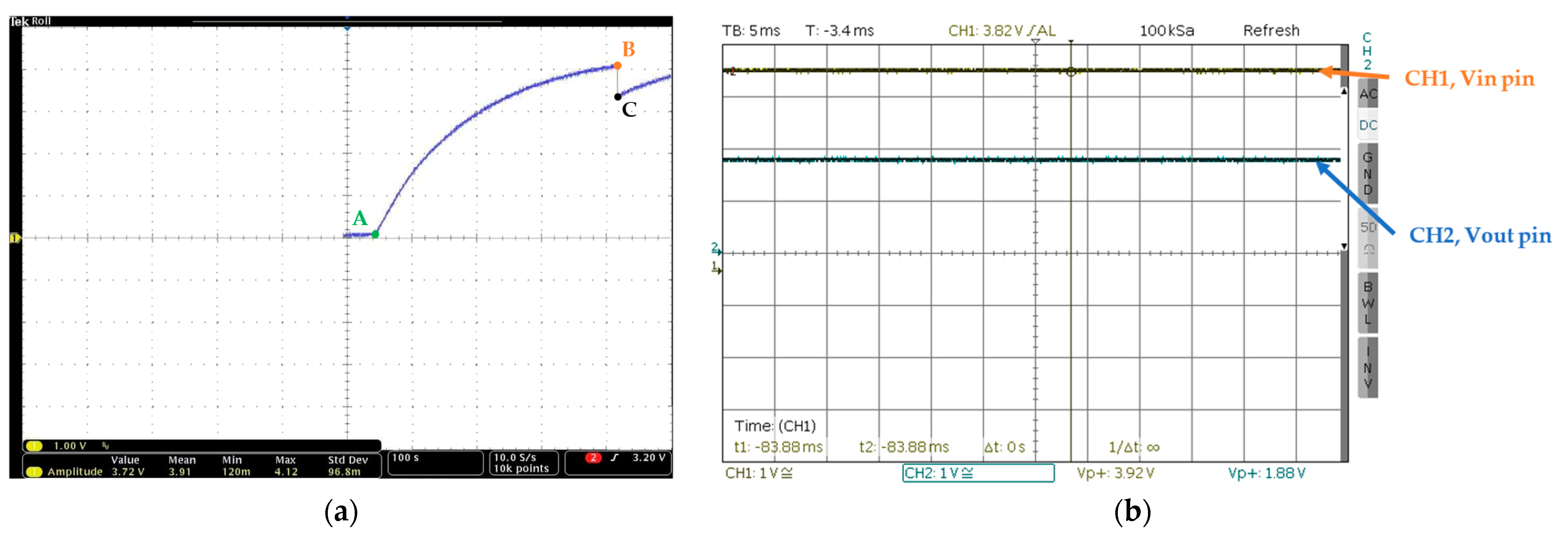
| Quadrant | Cantilever | ||||||||||||||
|---|---|---|---|---|---|---|---|---|---|---|---|---|---|---|---|
| 1 | 2 | 3 | 4 | 5 | |||||||||||
| f [Hz] | Q | φ [°] | f [Hz] | Q | φ [°] | f [Hz] | Q | φ [°] | f [Hz] | Q | φ [°] | f [Hz] | Q | φ [°] | |
| 1 | 465.4 | 1751 | - | 465.3 | 2028 | 19.34 | 464.8 | 1909 | 32.47 | 465.3 | 1854 | 19.21 | 456.2 | 1824 | 23.12 |
| 2 | 462.2 | 1383 | 19.33 | 464.6 | 1423 | 23.01 | 468.3 | 2397 | 21.56 | 468 | 1357 | 27.7 | 463.4 | 2069 | 32.46 |
| 3 | 462.3 | 1782 | 21.48 | 475.2 | 930 | N/A | 482.2 | 820 | 44.1 | 463.6 | 1865 | 57.49 | 463.7 | 1735 | N/A |
| 4 | 464.2 | N/A | 4.63 | 476.1 | 1915 | 18.41 | 464.1 | 1600 | 20.89 | 464 | 1634 | 19.51 | 461.7 | 1790 | 10.84 |
| Quadrant | Cantilever | ||||||||||||||
|---|---|---|---|---|---|---|---|---|---|---|---|---|---|---|---|
| 1 | 2 | 3 | 4 | 5 | |||||||||||
| f [Hz] | VRMS [V] | φ [°] | f [Hz] | VRMS [V] | φ [°] | f [Hz] | VRMS [V] | φ [°] | f [Hz] | VRMS [V] | φ [°] | f [Hz] | VRMS [V] | φ [°] | |
| 1 | 465.4 | 0.46 | - | 465.3 | 1.36 | 19.34 | 464.8 | 1.84 | 32.47 | 465.3 | 2.08 | 19.21 | |||
| 2 | 462.2 | 1.28 | 19.33 | 464.6 | 1.28 | 23.01 | 468.3 | 0.85 | 21.56 | 468 | 1.2 | 27.7 | |||
| 3 | 462.3 | 1.15 | 21.48 | ||||||||||||
| 4 | 476.1 | 2.4 | 18.41 | ||||||||||||
| Device | Material | Dimension (mm3) | Resonant Frequency (Hz) | Acceleration (g) | Optimal Resistance (kΩ) | Q-Factor | Powermax (µW) | Power Density (µW· mm−3·g−2) |
|---|---|---|---|---|---|---|---|---|
| PZ-EH | ScAlN | 2 × (2.5 × 5.7 × 0.412) | 465.3 | 1 | 1000 | 220 | 2.53 | 0.215 |
| Liu et al. [27] | ScAlN/AlN | 4.02 × 4 × 0.551 | 1357.5 | 1 | 50 | 970 | 1.7 | 0.192 |
| Liu et al. [27] | ScAlN/AlN | 4.02 × 4 × 0.551 | 1284.25 | 1 | 95 | 756 | 10.74 | 1.214 |
| Gablech et al. [28] | AlN | 4 × 2 × 0.372 | 2520 | 1 | 67.56 | 900 | 3.1 | 1.04 |
| He et al. [29] | AlN | 13 × 14 × 0.402 | 160.6 | 1 | 240 | NA | 54.1 | 0.74 |
| Elfrink et al. [30] | AlN | 6.01 × 5 × 0.525 | 572.28 | 1 | 447 | 252 | 30 | 1.9 |
| Zhao et al. [13] | AlN | 11 × 12.12 × 0.502 | 230.4 | 1 | 70 | NA | 3.249 | 0.048 |
| Yu et al. [12] | PZT | 11 × 12.4 × 0.552 | 234.5 | 0.5 | 220 | NA | 66.75 | 3.55 |
| Jackson et al. wide [10] | AlN | 8.2 × 7 × 0.562 | 149 | 0.2 | NA | 124 | 3.07 | 2.38 |
| Jackson et al. trapez. [10] | AlN | 8 × 3.5 × 0.562 | 118 | 0.4 | NA | 131 | 1.15 | 0.46 |
| Jackson et al. narrow [10] | AlN | 7.5 × 1 × 0.562 | 97 | 0.4 | NA | 115 | 0.38 | 0.56 |
| Jia et al. [15] | AlN | 3.5 × 3.5 × 0.412 | 210 | 0.27 | NA | NA | 20.47 | 55.63 |
Disclaimer/Publisher’s Note: The statements, opinions and data contained in all publications are solely those of the individual author(s) and contributor(s) and not of MDPI and/or the editor(s). MDPI and/or the editor(s) disclaim responsibility for any injury to people or property resulting from any ideas, methods, instructions or products referred to in the content. |
© 2024 by the authors. Licensee MDPI, Basel, Switzerland. This article is an open access article distributed under the terms and conditions of the Creative Commons Attribution (CC BY) license (https://creativecommons.org/licenses/by/4.0/).
Share and Cite
Muscalu, G.; Firtat, B.; Anghelescu, A.; Moldovan, C.; Dinulescu, S.; Brasoveanu, C.; Ekwinska, M.; Szmigiel, D.; Zaborowski, M.; Zajac, J.; et al. Piezoelectric MEMS Energy Harvester for Low-Power Applications. Electronics 2024, 13, 2087. https://doi.org/10.3390/electronics13112087
Muscalu G, Firtat B, Anghelescu A, Moldovan C, Dinulescu S, Brasoveanu C, Ekwinska M, Szmigiel D, Zaborowski M, Zajac J, et al. Piezoelectric MEMS Energy Harvester for Low-Power Applications. Electronics. 2024; 13(11):2087. https://doi.org/10.3390/electronics13112087
Chicago/Turabian StyleMuscalu, George, Bogdan Firtat, Adrian Anghelescu, Carmen Moldovan, Silviu Dinulescu, Costin Brasoveanu, Magdalena Ekwinska, Dariusz Szmigiel, Michal Zaborowski, Jerzy Zajac, and et al. 2024. "Piezoelectric MEMS Energy Harvester for Low-Power Applications" Electronics 13, no. 11: 2087. https://doi.org/10.3390/electronics13112087
APA StyleMuscalu, G., Firtat, B., Anghelescu, A., Moldovan, C., Dinulescu, S., Brasoveanu, C., Ekwinska, M., Szmigiel, D., Zaborowski, M., Zajac, J., Stan, I., & Tulbure, A. (2024). Piezoelectric MEMS Energy Harvester for Low-Power Applications. Electronics, 13(11), 2087. https://doi.org/10.3390/electronics13112087






